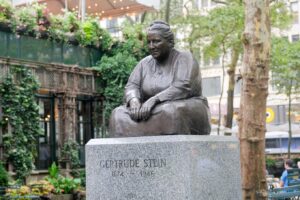
GERTRUDE STEIN (1874-1946)
“If you can’t say anything nice about someone- come sit next to me.”
The first time I heard of Gertrude was after watching the 1960’s screwball comedy, “I love you, Alice B. Toklas.” I remember thinking that Gertrude Stein, with her avant-garde Buddha-like presence and quirky Alice had a story to tell; one that far beyond Peter Seller’s comedy and my own boring middle class suburban life.
The statue installed in 1992 in Bryant park, NY, located next to the NY Public Library, is 225 lbs. of polished bronze and sits on a pedestal, displaying Ms. Stein in a seated position with the gravitas, given only to The Buddha himself. Apparently the Parisian sculpturer Jo Davidson had the same vision of Gertrude as I did- not only was she a trailblazing author, arts patron, literary salon facilitator but her gender-blending lifestyle allowed others to become comfortable in their own skin; a necessity artists must possess if they want to create true, unadulterated self-expression.
A trust fund baby, Gertrude moved to Paris when she was 30. There she met Alice, her mustached unconventional life partner. As a fan of cubism and eclectic art, Gertrude purchased paintings of little-known artists and displayed their works on the walls of her Parisian apartment (Picasso, Matisse, Cezanne, Gaugin, Renoir Toulouse-Lautrec). Soon the “almost famous” writers arrived (Sherwood Anderson, F. Scott Fitzgerald, Ezra Pound, T.S Eliot) and the Literary Salon was born. Gertrude’s apartment became a mecca where a community of writers networked, critiqued and inspired each other to greatness. Gertrude’s novel, “The Autobiography of Alice B. Toklas,” is, and was, considered a literary superstar (she created what is now known as the unreliable narrator and gave the literary world a new way to tell their own story by redefining the scope of autobiographies.)
Then there’s the relationship between Gertrude and Alice that single-handedly reconstructed gender by questioning what it meant to be male/female; feminine /masculine; even husband and wife. We’re still questioning these terms decade later but it was her bravery that sparked the conversation. Yes, she affirmed, we can say that out loud.
Gertrude lived her life as a work of art. She was a collection of diversity; a patron of the arts, author, philanthropist, cultivator of culture and defender of human rights. She was larger than life. Her memory, chiseled in bronze and set upon a pedestal, sits for all to see. When you visit her statute, sit next to her for a while. Think. Then ask yourself, what can I do to make the world a better place? If you think you can accomplish one iota of what Gertrude did, then you’re sitting pretty. Otherwise, you have work to do, my statue-loving friend. Lots of work.